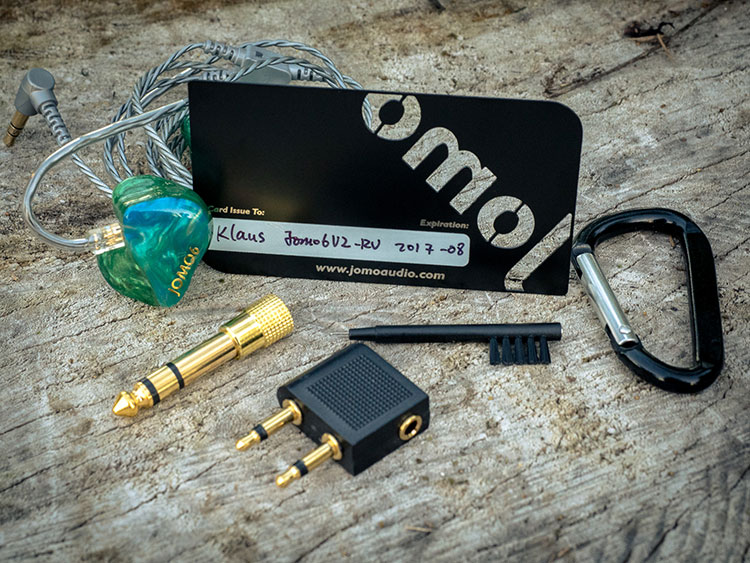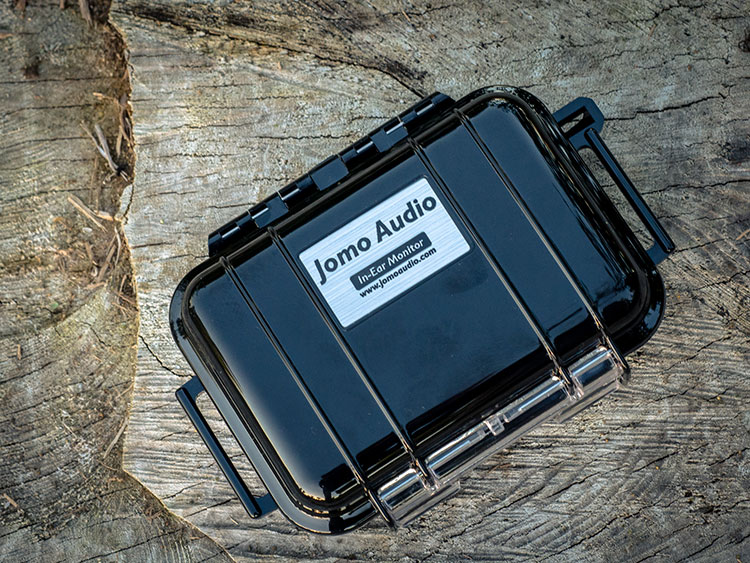Sound Impressions
The new Jomo6 has quite a complicated setup: six drivers in a 5-way design! One sub, dual low, one mid, one high, and one super high BA driver. That is very impressive. But a well-equipped kitchen alone does not make a good chef. So let’s take a listen.
Summary
Jomo advertises a slight v-shape. But fear not, we are not talking about fatigue in the slightest! Notes have a dreamily liquid sound with a lot of space in a very big soundstage. The 6V2 does have a slightly warm character with a pleasing amount of weight and good dynamics for pure musical enjoyment.
I do realize how cheesy this sounds, but it is true and it deserves a mention. While writing this review, I had several times where I just shut the laptop to enjoy the music and give it my full attention. Especially with Classical music.
Bass
With three of six drivers dedicated to low frequencies, one would be excused to fear a bass-heavy earphone. But this is not the case. In fact, the new Jomo6 has perceptively less bass than most of my earphones even though I have very few monitors with v-shaped signatures. On some tracks, I wouldn’t even mind a bit more punch and slam.
The bass performance impresses the most when a pipe organ kicks in and demands the single sub driver to flex its muscles. The technical prowess is impressive and the low-end rumble adds a lot to the atmosphere. While ground and bottom are very solid, punch and boom take a back seat when put into relation. This results in a more mellow presentation but with neither bass bleed nor too much warmth.
If a track demands it, oomph will be there, but this might not be the first pick when searching an in-ear for EDM or aggressive Electronica. The focus lies much more in attention to detail, picking up single bass guitar plucks or texture of strings.
When fed with Thrash Metal, bass proves to be quick and tight, but bass itself is not very airy. It feels like (low) fundamentals are slightly pronounced. It’s really much more about atmosphere than prominence or forwardness than other IEMs that excel at PRaT.
Mids
There is a single driver operating the mids – not especially much when considering a total of 5 drivers, but it performs very well. Voices are very well separated and hardly colored at all. There is but a hint of warmth when comparing to reference models.
Blues Pills, a band with sudden success in the Rock industry not too long ago, has quite warmly mixed vocals on their S/T album. The track Little Sun has a firm spot in my audio playlist to see how audio gear deals with overly thick and close mids.
The 6V2 performs favorably allowing just enough space to the listener and not adding further warmth to the source. This is a track where many have failed.
I listen to a lot of piano music and I usually pick up imbalances quickly, but I can’t figure out any overly pronounced notes this time around, though I do notice a slight coloration that is difficult to describe and much easier to not take notice of.
Voices have a nice fullness with a hint of crunch but steer away from sounding tinny or edgy. Vocals, in particular, take advantage from the super high tweeter that allows them to breathe nicely.
From an imaging perspective, mids are set further back in distance to the listener, but hardly so. It is more like bass and treble are surrounding them to the sides, not pressing down on mid frequencies at all.
On a less pleasing note, I noticed some channel imbalance between 1-3 kHz with the right monitor outputting more pressure. It’s not something you’d easily notice when listening to music, but it might be important for a sound engineer.
Treble
Treble is smooth and slightly laid back between 6-8 kHz. Highs evade sibilance. Violins have a nice softness without losing presence. Treble energy mostly comes from 9-10 kHz which results in quick decay.
The extension cannot match a reference open headphone, but I am very pleased with the amount of air that is left above 13 kHz. Though the high frequencies are not reference material as for linearity, I did not have a single track on my playlist in which I found them to be harsh, sibilant, or lacking.
Soundstage
The soundstage is deep as it is wide, scaling formidably with the material. This might be the monitor’s strongest suit. Vocals by the likes of Samora Pinderhughes or Gregory Potter are intimate, but with Classical recordings, the listener is put into the 5th row. As separation is great too and notes have a nice weight, imaging is very well-rendered and realistic.
Select Comparisons
InEar StageDiver 2
While the SD2 is only a two-driver universal, technically one should not expect it to come near the capabilities of Jomo6. However, I decided to pull it into the comparison for tuning alone. It is my favorite universal earphone because its tuning is fairly close to neutral but it also has a very smooth treble.
Where it falls short is with the extension on both ends. This is where Jomo comes into play. While I find mids to be nearly equally well-tuned, both rendering realistic voices, the 6V2 adds quantity and quality on both ends. Especially in the low-end, Jomo impresses with a tight and voluminous rumble that few earphones can achieve.
When the SD4 was announced, many hoped it would be the audiophile successor for SD2, but despite being another great IEM, it did not reach most SD2 fans. SD4 and Jomo6 both have a v-shaped signature, but the 6V2 loses none of its lush mids and great timbre, performing as the better “audiophile SD2” in my opinion.
With the same strengths as the SD2, but much better low-end and just as smooth treble with great extension, the Jomo6 V2 is a really good musical all-rounder that should be a worthy upgrade for fans of the SD2.
Rhines Stage 5
Big sound with great bass performance, large soundstage, and extended and smooth treble. This is how the Stage 5 moved away from previous Compact Monitors Stage monitors. It is unique in the line-up as the Stage 7 brings back the forwardness of the other Stage earphones.
When compared to Jomo, the Stage 5 is darker and warmer sounding. It has a noticeably thicker mid-range but it also adds more boom. The Jomo6’s bass boost is far more controlled and subtle. It is easier for me to pick up details in the bass with the Stage 5.
Stage 5’s rendering of voices sounds extremely smooth and overly warm, opposed to a more neutral sound of the Jomo6. Neither are edgy or have issues with sharpness, though Stage 5’s rendition is more relaxed. Both extend well with high frequencies. To my ears, Stage 5’s treble is flatter but also overall darker due to the huge bass that is never fully balanced like with the Stage 4.
Soundstage is big and especially deep on both monitor designs, with Stage 5 having even more distant vocals but also closer bass. It should be easy to favor one over the other, depending on personal preferences. Both designs are two different approaches with the same aim: to enjoy music without fatigue.
Vision Ears VE6
Often being compared to the full-size open headphone Sennheiser HD800, the VE6 X2 is still the reference to beat for many audiophile CIEM fans. Fittingly, it features the same driver count as the Jomo6 and thus warrants a comparison.
Jomo6 V2’s tuning is closer to VE6 X2 than X1. (X1 is with the bass boost turned on.) Bass quantity is really not that much on V2, but it has a great presence and more pronounced sub-bass. The VE sends out some more punch and appears to be quicker at first listen, but the texture comes better through on the Jomo.
Neither of the two monitors bleeds into mids and leaves great space for voices to breathe. However, once adjusted to VE6’s mids, I do believe they have a better timbre and less coloration.
Furthermore, on some tracks, the mids can appear crowded on the Jomo, as they have a similar lightweight feel. On the other hand, VE6 does not shy away from S-sounds, though neither could be termed as being edgy or sibilant, it does result in a more analytical presentation compared to some added smoothness by Jomo Audio.
VE6 continues to impress with more air and a more transparent treble, which again has a slight tendency to steer into analytical territory. Jomo 6 is smoother in that regard, lowering the 7 kHz area to just the right amount for pure musical enjoyment and then peaking at the top high end.
If technical accuracy is a priority, I would say VE6 is the better monitor. Both earphones have a great width in the soundstage, but Jomo6 beats the VE6 (both X1 and X2) in depth. VE6 shines with better separation, though, and shows less effort to unveil micro details.
If you find either VE6 too analytical, the new Jomo6 is a good option to look into. Overall they sound even smoother and easily enjoyable – regardless of music genre, whereas the VE6 still manages to beat Jomo with snappier bass, less coloration, and higher resolution overall.
If you enjoy the VE6 monitor tuning, though, the Jomo6 might be too colored and not lightweight enough for you.
Synergy
The Jomo6 are not so dependent on the source as I would have thought. It handles different outputs quite well. I feared that a 5-way crossover might break apart with a non-optimal source, but this is not the case.
At 25 ohms impedance and 114 dB sensitivity, the Jomo can forgive a little background hiss but also reach high volumes quickly. The 6V2 mostly improves in dynamics and soundstage with a better source.
Cozoy Aegis
With the newly released iPhone 7, external DACs and amps will appreciate a further boost in sales even though the market was already growing. Though Cozoy just announced the successor to Aegis called Rei, this is still my favorite mini-DAC due to its small size and versatility.
Occasionally I criticize Aegis for sounding somewhat harsh and forward, a bit too direct for my taste. (I prefer to use my Oppo PM-3 without Aegis directly through the headphone output.)
But luckily the Jomo6 V2 does not have issues with thickness and thus pair quite well with the Aegis. The background becomes darker and the treble has more air. Mids loosen up further too, allowing better separation, but this was not an issue, to begin with.
If you need the versatility or the headphone output of your smartphone/ computer is bad, you can safely connect the Jomos to the Aegis. The somewhat artificial or analytical character of the Cozoy Aegis cannot outweigh the musicality of the 6V2.
Chord Hugo
The soundstage master strikes again! This is a combo a highly recommend. When paired together, the Jomo prove to be very transparent and lively in a big soundstage. Details are retrieved with ease, everything flows smoothly and blends into another without the slightest clouding or masking.
Bass gains authority with respectful distance to the listener while voices float in the middle of the room, intimately facing the listener. Cymbals hit cleanly with fast decay from the sides, even in the busiest of passages of complex music. This is audio poison and the very reason I say portable hifi is my hobby!
iPhone 6S Plus
The 6V2 plays effortlessly and is fully enjoyable on my iPhone output. The soundstage is larger than I would have expected and neither end of the frequency range seems to take a hit.
The background is black, all instruments are well defined and the timbre is good. Compared to Hugo or Aegis, the audio is a bit more forward and closer to the listener yet loses none of its depth. The Jomo 6 is a great companion for music and videos on the go alike.
Our Verdict
The new 6V2 is the flagship of Jomo Audio’s Signature series, an audiophile category next to the Pro Audio series. As I already hinted, the Jomo6 V2 is not necessarily a v-shaped monitor.
The bass elevation is modest and mostly impresses with sub-bass rather than a forward slam. With mids being well separated and airy, I can absolutely deal with a hint of coloration. The same goes for the smooth treble that does preserve a little sparkle but overall plays it very safe. It’s a tuning that does not want to stress the listener but also tries to be neutral in the most enjoyable way.
The great weight of fundamentals and soft treble – though with good air – derives from what a usual reference monitor would reproduce (presumably including the Jomo6R). But it all comes together nicely and allows the music to really pull you in.
It might just be in the details, but it is the details that turn a monitor that could have been analytical into pure musicality without fatigue. Picking up on the kitchen reference earlier, I am happy to say the dish served on this plate is very delicious!
The Jomo6 V2 are great all-rounders that impress with a big soundstage and do well with any genre. The bass does extremely well with movies too and I recommend the Jomo6 V2 to users that are looking for a good all-rounder with multiple applications and sources.
Jomo Audio Jomo6 v2 Specifications
- 6 balanced armature drivers
- 5-way crossover
- triple-bore design
- single sub, dual low, single mid, single high, single super high
- 25 Ohm @ 1kHz
- 20 Hz – 20 kHz
- sensitivity: 114 dB




